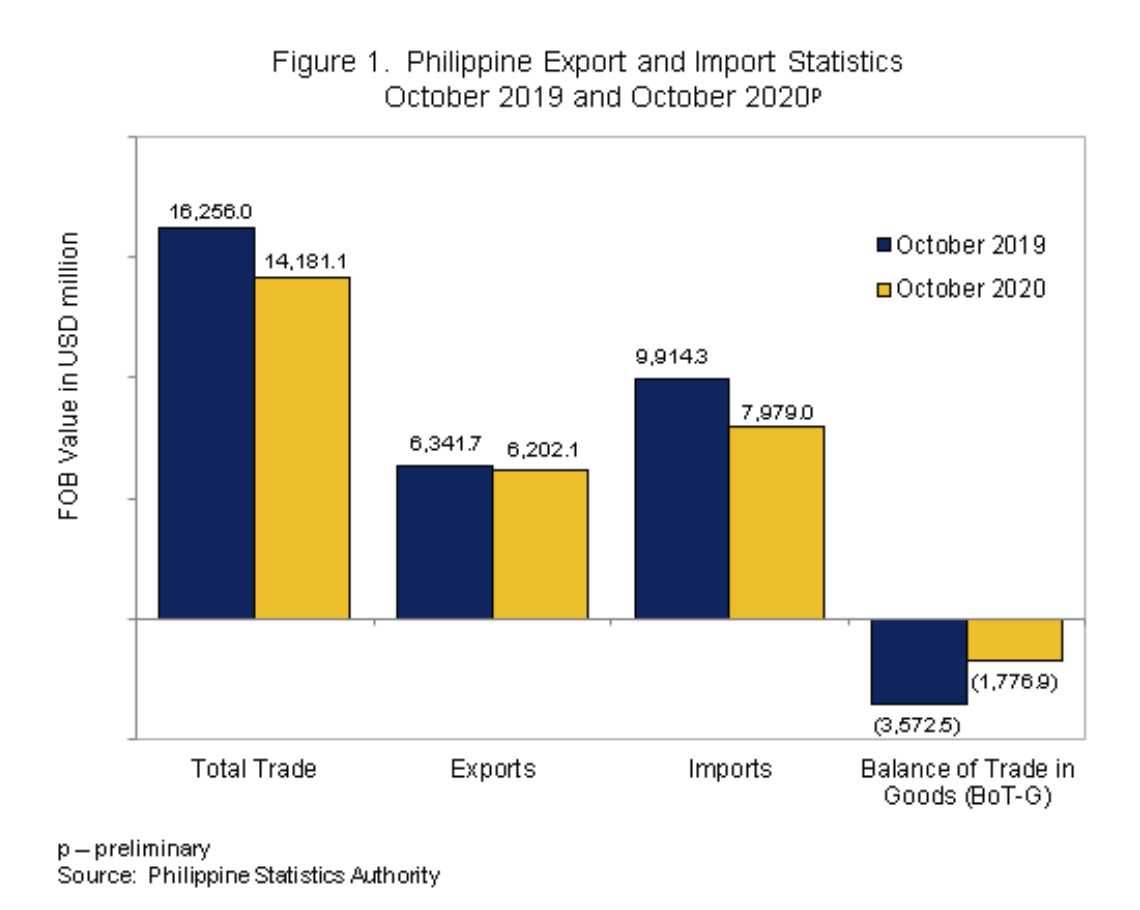SUMMARY
This is AI generated summarization, which may have errors. For context, always refer to the full article.

Despite optimism over the development of COVID-19 vaccines, the Philippine economy will continue to struggle as it claws back up from recession, with the country’s trade movements remaining anemic.
Latest figures of the Philippine Statistics Authority showed that exports continued to contract and imports fell for the 18th straight month in October.
Exports recorded a 2.2% drop to $6.2 billion, while imports fell 19.5% to $7.98 billion.
Dips were recorded in most commodity groups, except for merchandise exports to China and Southeast Asia posting double-digit growth. Capital goods imports also increased in October compared to September.
Exports to the United States comprised the highest export value, followed by Japan, China, Hong Kong, and Singapore.
Meanwhile, China was the top importer in October, followed by Japan, the US, South Korea, and Indonesia.

The vaccine, once widely available, will most likely boost consumer spending and trade. But ING Bank Manila senior economist Nicholas Mapa sees a slow rollout.
“Despite early optimism derived from vaccine development, we believe vaccine deployment will not be instantaneous, especially in the Philippines with authorities yet to secure a single dose of the vaccine as of this writing,” Mapa said. (READ: TRACKER: Which COVID-19 vaccines are being eyed by the Philippines?)
Vaccine czar Carlito Galvez Jr earlier said the government aims to vaccinate around 60 million to 70 million of its citizens in 3 to 5 years, roughly 60% to 70% of the country’s population of 107 million. (READ: Philippines aims to vaccinate 60M-70M people in 3 to 5 years)
With the slow rollout, Mapa expects “import demand to recover, but at a very shallow trajectory leading to a very gradual and slow recovery for the Philippines as it operates with diminished productive capacity.”
Acting Socioeconomic Planning Secretary Karl Chua said a “calibrated and gradual resumption” of businesses, while maintaining strict health protocols, is needed to improve trade figures.
“Fundamental to these efforts is the provision of safe and regular transport to allow for worker mobility,” Chua said.
Forecasts
Multilateral lenders Asian Development Bank (ADB) and World Bank both recently lowered their growth forecasts for the Philippines.
The ADB revised downward its gross domestic product (GDP) outlook to -8.5% in 2020 from -7.3%, as household consumption and investments fell more than expected.
Meanwhile, the World Bank sees a contraction of 8.1%, due to multiple shocks like the COVID-19 pandemic, tropical cyclones, and the overall global recession. – Rappler.com
Add a comment
How does this make you feel?


![[Time Trowel] Evolution and the sneakiness of COVID](https://www.rappler.com/tachyon/2024/02/tl-evolution-covid.jpg?resize=257%2C257&crop=455px%2C0px%2C1080px%2C1080px)


![[In This Economy] A counter-rejoinder in the economic charter change debate](https://www.rappler.com/tachyon/2024/04/TL-counter-rejoinder-apr-20-2024.jpg?resize=257%2C257&crop=267px%2C0px%2C720px%2C720px)
![[Vantage Point] Joey Salceda says 8% GDP growth attainable](https://www.rappler.com/tachyon/2024/04/tl-salceda-gdp-growth-04192024.jpg?resize=257%2C257&crop_strategy=attention)
![[ANALYSIS] A new advocacy in race to financial literacy](https://www.rappler.com/tachyon/2024/04/advocacy-race-financial-literacy-April-19-2024.jpg?resize=257%2C257&crop_strategy=attention)


There are no comments yet. Add your comment to start the conversation.